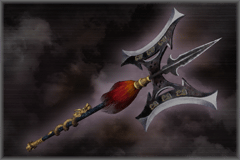
Registration Data
Abilities:
Overwhelming Force (Semblance) — Unstoppable: The set path of (a) Bu may not be deterred - difficult to alter Feng's approach once momentum accrues. Immovable: (A) Bu shalt never be wrested from the set path - difficult to transpose Feng's current position unwillingly. Titan: None extoll the virtues of strength better than (a) Bu - the dimensions of Feng's frame doubles.Equipment:
Armor: Bodysuit - flexible material made of unstable molecules with expansive ceramic plating adorning hard points. Fangtian Huaji ("Heavenly Halberd"/"Sky Piercer") — Melee: Gargantuan halberd - twin moon blades adorn the polearm, ending in a spear-point. Ranged: Break-action, single-shot anti-material rifle - chambers 20 mm caliber rounds. Ammunition: HE, HEI, AP, API, APDS - dust ammunition variants.Alignment: Neutral Good Short Bio: First year student to Beacon academy; member of Team VBSS; partner to Vasili Thana.
Dossier of Bu, Feng
Bu Mandate of Rage


